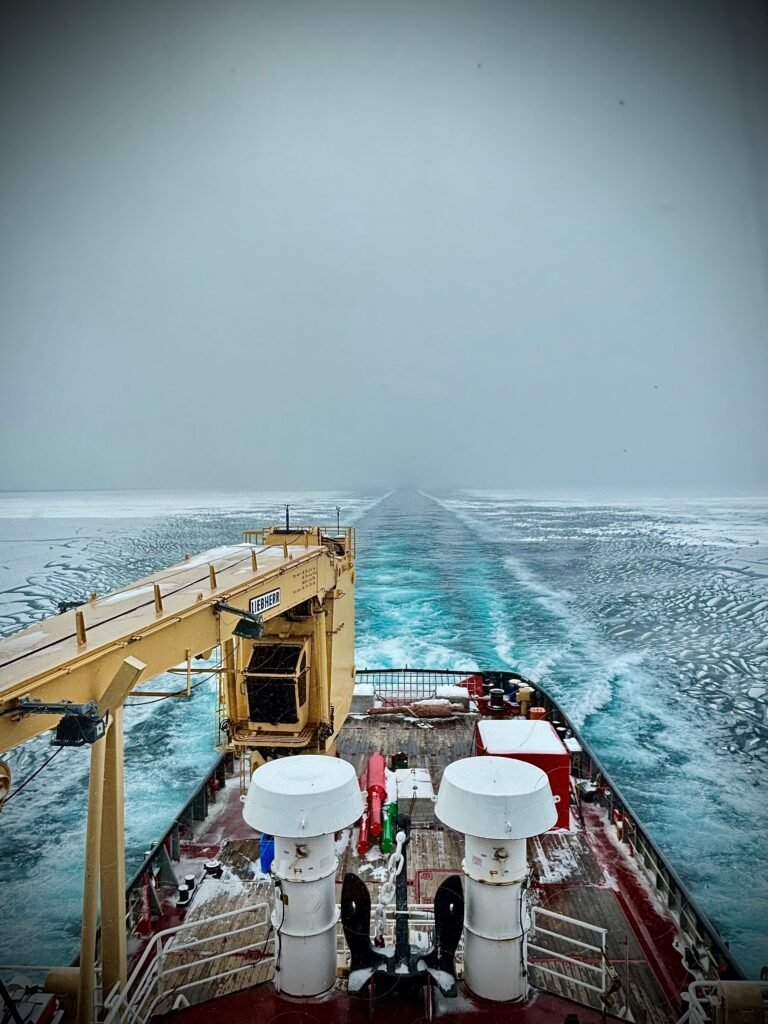Members from the Fisheries and Oceans Canada, Lower Trophic Food Webs lab recently returned from a five-day voyage aboard the CCGS Samuel Risley—one of the impressive Canadian Coast Guard icebreakers servicing the Great Lakes. This mission was an opportunistic sampling effort, aimed at collecting water samples for the binational collaborative winter limnology research ‘WinterGrab’ 2025 project.




The Great Lakes WinterGrab is a relatively new endeavour, established in the winter of 2022, is a unique partnership between various academic and government research institutions on both sides of the Canada-US border. Most lake research is typically conducted from early spring to late fall (during the ‘ice-free’ period), which has resulted in a widespread deficiency in winter limnological data. Thus, the WinterGrab was proposed to gather mid-winter data across the entire the Great Lakes basin and to improve our scientific understanding of how physical, chemical, and biological processes within the lakes differ during the freeze of winter. A data manuscript with the 2022 winter grab detailing the project was recently published open-access in Limnology and Oceanography. https://doi.org/10.1002/lol2.10447


Collecting lake samples from an icebreaker was a cool experience (pun intended) 🥶! Our first morning out in Lake Huron (February 18) brought temperatures frigid enough to freeze our lines and instruments almost immediately after they were pulled from the water. One unique challenge for winter sampling from an icebreaker was sampling with brash ice floating at the surface. Brash (pictured above) is the term given to ice once it has been broken away from fast ice, or ice attached to the shore (aboard the CCGS Samuel Risley, brash is created constantly while in transit by the breaking action of the ship). Because these floes are large and moving, brash ice can potentially damage sensors, nets, or sampling devices if not adequately cleared during sampling. For this reason, we often used long pike poles to push ice away from the ship.
In addition to participating in fun field operations, we also completed a fair bit of sample processing in our makeshift lab space aboard the ship. Here, I was busy processing samples collected for various chemical and biological parameters, including:
🧪 Nutrients;
☣️ Primary Production;
🦠 Phytoplankton and 🦐 Zooplankton;
🧬 Microbial DNA;
⚛️ Organic carbon compounds; and more!
Each preserved and prepared sample was then carefully labelled with all relevant information and paired with in-situ field data and records so that the samples were ready for shipment to partner agencies upon return to CCIW in Burlington. Partner laboratories will complete analysis of the many parameters sampled during the 2025 winter grab.


Since the Samuel Risley is not equipped as a science vessel (compared to the CCGS Limnos, where our team completes most lake-wide work), there is no laboratory space onboard, meaning we needed to get creative with establishing a space to work with the samples we collected. We are thankful that the commanding officer granted us permission to take over part of their multipurpose exercise room as lab space – it was ideal for our work purposes and served as a spot to warm up in between stations.

Another very interesting aspect of sampling aboard the Samuel Risley was learning how icebreakers operate and assist in winter missions termed “ice-ops”. Shipping between the Soo locks and Welland Canal continues year-round, and these large commercial vessels require icebreakers to escort them through the thick ice or can get stuck as happened this year to the Manitoulin. Often, the ship is notified the evening before or morning of its tasked icebreaking. The location of the icebreaking depends on operational needs on that particular day, making life aboard an icebreaker within the Great Lakes a big adventure.

Considering the return to significant lake ice this year, after a multiyear hiatus caused by mild winters, the CCGS Samuel Risley and other icebreakers in the region (like the CCGS Griffon, USCGC Mackinaw, and a number of smaller cutters for local work) have been busy keeping regional shipping corridors navigable. As of our last morning onboard, nearly 65% of Lake Huron was covered in ice, while Lake Erie had 95% ice cover. Below is a time-lapse of the CCGS Samuel Risley in action, freeing the freight vessel Algoluna in the St. Clair River near the US settlement of Algonac.
During our time onboard, we sailed through the St. Clair River into Lake St. Clair and the Detroit River, and eventually steamed north across Lake Huron to Goderich. This granted us the opportunity to collect data from six spots along the way! Looking back and reflecting on yet another successful mission, we are grateful for our colleagues at the Canadian Coast Guard for this incredible opportunity.



